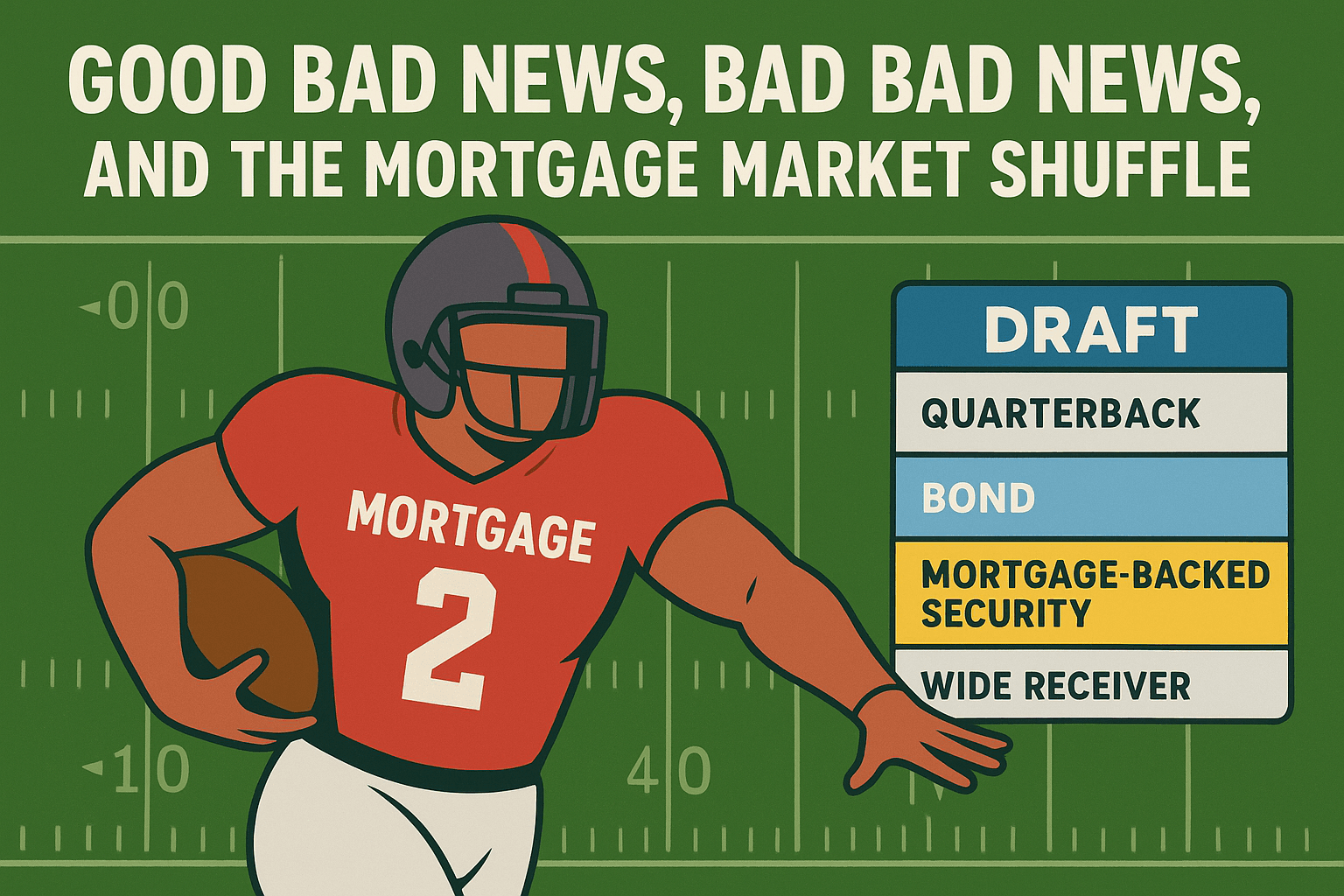Bad Bad News: Inflation
Inflation is like that uninvited guest who eats all the chips at the party and then asks if you’ve got guacamole too. Nobody wants it, but when it shows up, the Federal Reserve feels the need to step in and take charge.
The Fed’s usual move? Raising/holdng interest rates. It’s their way of pulling money out of the economy, hoping to cool things down. They could dust off the old playbook and make banks hold onto more reserves—but that hasn’t been seen in decades. Either way, inflation = higher rates in the mortgage world. Definitely Bad Bad News.
Good Bad News: Jobs Reports
Now, this one is tricky. A poor jobs report is never good news on the human side—people struggling to find work is tough. But for the mortgage market? Like it was last Friday, it turned into “Good Bad News.”
Here’s why: fewer people working means less spending. Less spending means less pressure on prices (a.k.a. less inflation). And when inflation cools, the Fed might loosen its grip on the money supply. That can bring rates down. It’s a bittersweet twist—bad for workers, but potentially good for borrowers. I think that poor jobs report from September 5th cementing in the probability that the Federal Reserve is going to lower the Federal Funds rate come Mid-September.
Bad Bad News: War
War doesn’t just rattle world peace—it shakes up the financial markets too. How has the Ukraine/Russia war affected the Mortgage-Backed Securities Market here in the US? There is more of a direct link than you might think, and here is just one small example:
Wars affect supply chains, especially energy. Don’t know if you noticed, but slowly over the 4 years we’ve seen gas prices rise. As crazy as this sounds, the US is a NET exporter of petroleum. That is correct—we are sending more petroleum to other countries than we are receiving/saving for ourselves. This crosses party lines. It happened with Biden and is continuing with Trump. We send out nearly 4,000,000 barrels a DAY. One of the reasons is that Eastern European countries have been limited (and some cut off) from their Russian supply. If the US doesn’t step in to help, that could mean a European recession, which would have far more implications here at home other than paying $4+ for a gallon of gas.
Because there is less gasoline staying home at our gas pumps, the big gas companies are charging more for it—because gasoline has such an inelastic demand curve (how’s that for a reference back to High School Economics Class 😊).
So higher energy prices at home? That pushes inflation. Definitely Bad Bad News.
And here’s where it loops back to mortgage rates: when the U.S. issues more bonds to help fund spending, they compete directly with mortgage-backed securities. Imagine it like a fantasy football draft: investors are the managers, bonds and MBS are the players. If bonds suddenly look like the star quarterback, they get picked first. To stay competitive, MBS has to offer more upside, which in mortgage terms means higher rates.
Bad Bad News… or Good Bad News? Tariffs
This one’s a head-scratcher. Tariffs are like my moody teenagers—you never quite know how they’ll act.
In theory, tariffs bring in revenue for the government (one of only three ways Uncle Sam fills his wallet: taxes, tariffs, and bonds). But if higher tariffs scare off foreign businesses and imports dry up, then there’s no revenue to collect in the first place. With the courts just ruling that Trump’s tariffs were illegal (and the potential of having to return hundreds of millions of dollars to foreign businesses), this could turn into some real Bad Bad News for mortgage rates.
Here’s why: that leaves the government plugging the gap with—you guessed it—more bonds. And when more bonds hit the market, they compete directly with mortgage-backed securities. Think of it like a fantasy football draft: investors are the team managers, and they only have so many draft picks (dollars) to spend. If government bonds suddenly start offering better stats (higher yields), they become the first-round pick. That forces mortgage-backed securities to “sweeten the scouting report” and offer more return just to stay in the game. And just like paying up for a star running back, juicing those yields means higher mortgage rates.
So are tariffs Bad Bad News or Good Bad News? Well, just like draft night—you’ll have to wait and see who ends up on the roster.
Rocket Fuel: A Booming Economy
Finally, the big picture. If the economy shoots off like a rocket—more jobs, more paychecks, more shopping sprees—that’s great news for families and businesses. But in the mortgage world, it’s a red flag.
Under normal circumstances, more people spending more money = more demand for goods and services = higher inflation. And higher inflation means the Fed is unlikely to cut rates. So while your favorite restaurant might be packed and your neighbor just bought a new car, your mortgage rate is probably staying parked in the “not so low” zone.
The Takeaway
The mortgage market is like a seesaw, teetering between “Good Bad News” and “Bad Bad News.” Inflation, jobs, wars, tariffs—they all tug at rates in different ways. The tricky part is figuring out which kind of bad news we’re dealing with at any given moment.
So next time you see a headline about inflation, jobs, or tariffs, just remember: the mortgage market is like a fantasy football draft. Bonds and mortgage-backed securities are always competing for those first-round picks. And when bonds look like the MVP, mortgage rates usually have to rise to stay in the game.
